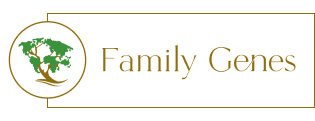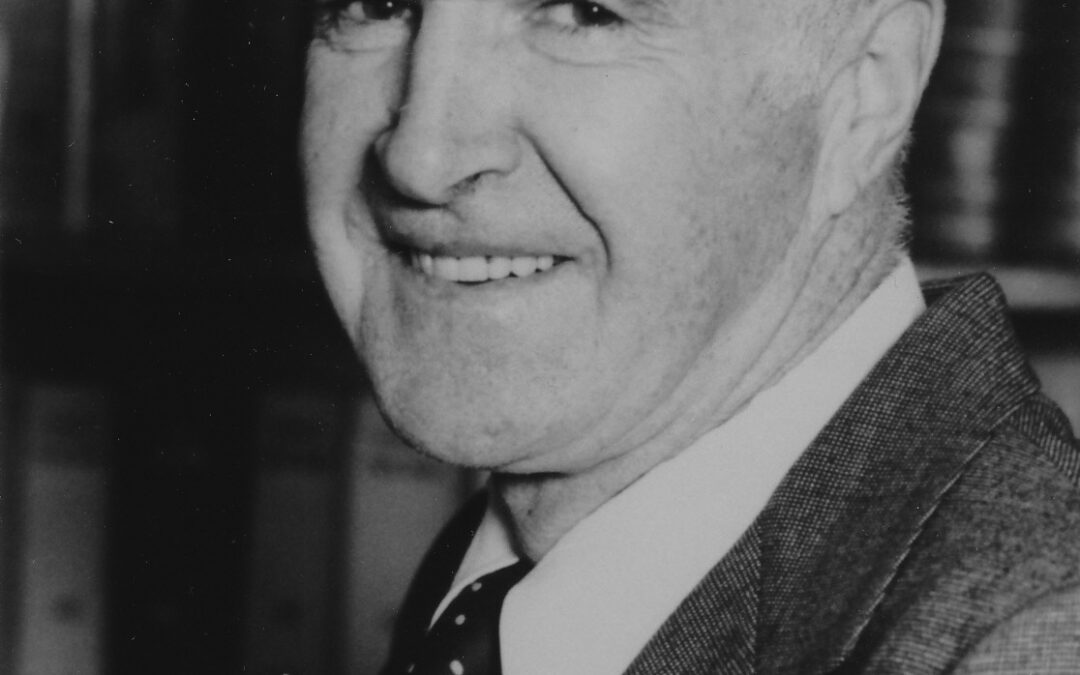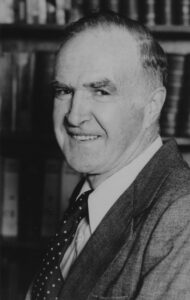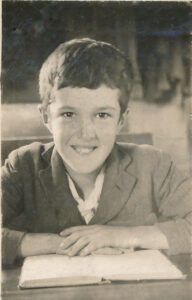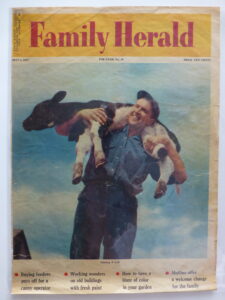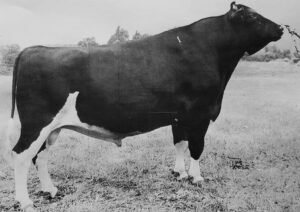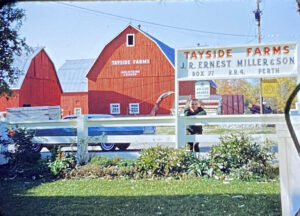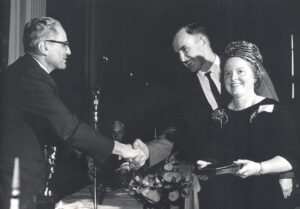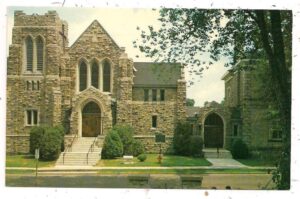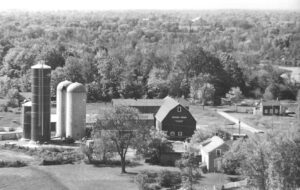- Born: 9 June 1917, Glen Tay, Bathurst Township, Lanark County, Ontario, Canada
- Married: 9 June 1945, in Perth, Lanark County, Ontario, Canada to Mary Evelyn Mather
- Died: 19 May 1997, Glen Tay, Tay Valley Township, Lanark County, Ontario, Canada
- Buried: Elmwood Cemetery, Perth, Lanark County, Ontario, Canada
- Family Tree: John Robert ERNEST Miller
- Relationship to author: father
- Children: 3 daughters, living and one son, deceased – John Herbert Miller 1950-2014.
Ernest Miller, or Ernie, Miller as he was known to family and friends, my father, was the second child of George HERBERT Miller (1886-1961) and Alice Whyte Ferrier (1888-1974). He was the 4th generation born on the family farm located on the edge of the village of Glen Tay, once a bustling mill village, one mill of which his great grandfather was a part owner.
The Miller-Dodds Property
This property originally occupied by his great grandparents, Ralph Dodds (1827-1907) and Louise McKay (1831-1906) and later, by his grandparents Robert George Miller (1847-1915) and Mary Elizabeth Dodds (1855-1937) and by his parents Herbert and Alice Miller. The farm was a narrow strip of land along the south bank of the Tay river and extended to the north bank of Grant’s Creek. It consisted of a rocky ridge of land rising from the water of the Tay and Grant’s Creek and extended across three lots of the 2nd concession of Bathurst.
The land was wooded, barren rock or swampy, with small pockets of arable land with rich loam soil. Ralph and Louise Dodds built and moved into the family home in 1859 when Ralph assumed a position at one of the mills owned by the Adams family. The attached land was sufficient to support the needs of the household. Ralph did not pretend to be a farmer! It seems he might have been more interested in the firewood required for fulling wool in a woolen mill not yet built or the ability to monitor activities at the mill and in the village from his front door!
In Ernest’s time the woodlot proved useful when the second or third growth of trees was sold to the town of Perth and harvested by work crews during the 1930 depression years. Ernest monitored what wood was taken and encouraged the workers to leave the maples while culling competing trees. This led to the development of a productive maple bush used for maple syrup production in the late 1940s and 1950s. The farm was sold about 2014 just before the death of his son John Herbert Miller (1950-2014). Today the farm hosts a number of private residences and parkland now owned by the township.
Early Years
Ernest Miller attended the Glen Tay public school and later obtain his 2nd form, or grade 10 equivalent today. He left school because his father was in poor health. It was also the midst of the depression and he was required to work on the farm. Ernest loved mathematics and would have excelled as an accountant. Instead he became involve in a series of agricultural courses and programs sponsored by the Department of Agriculture during the winter months. He began winning judging competitions and became part of a group of young farmers who took ideas for new farming practices back to their family farms.
By the 1940’s Tayside Farm was widely recognized for not only its fine purebred Yorkshire swine and its Shropshire sheep but most noteworthy, for the Tayside herd of registered Holstein cattle. The farm animals were exhibited widely and won many awards. Along with registration of the purebred cattle, individual milk production records were kept and the excellence of this herd later became a benchmark for Ernest when building a second herd.
During the 1940’s, when Malak Karsh, the noted Canadian photographer was taking pictures of “someone who was representative of farmers of the future” he stopped at Tayside. Ernie’s photo, along with a Tayside Holstein calf, later graced the cover of two Canadian farm magazines.
About 1939 Ernest, along with friends developed through the winter courses and the assistance of the local Agricultural Representative, worked to establish a Perth area Junior Farmer’s club and later other clubs in Lanark county. In the early 1940s over one hundred farm youths belonged to the club. Many soon went overseas to serve during WW II and some did not return. Later this group helped to organize a ‘girl’s club’ and the two clubs often met jointly. That may be where he met Evelyn although her brother was one of the early organizers of the group.
Through the 1930s and early 1940s Ernie was part of the “Glen Tay Redskins”, a local baseball team that frequently challenged a Dewitt’s Corners team and others. Several members of the Dewitt’s team were cousins.
Family
In 1945 Ernest Miller married Mary EVELYN Mather (1922-2010) in St. Paul’s United Church Perth. In 1946 a daughter was born, followed by a second daughter in 1948. However, 1948 turned out to be a memorable year on the farm as well. Ernest had assumed responsibility for the farm prior to his marriage in 1945 and part of the agreement was financial support of his parents in their retirement.
The Farm Years
In 1948 disaster struck! The Tayside herd of purebred Holsteins was given routine tests for bovine tuberculosis. At first it was of little concern as the herd was accredited with a clean bill of health for the past twenty years. Very shortly, Ernest was notified that the entire herd was declared positive and was ordered destroyed by the Federal government. He was devastated! Ernest had worked with his father since the first purebred cow and sire had been purchased. In one fell swoop the efforts of twenty years – the entire herd – was gone, and with it, the family income for three generations.
Ernest would not talk about this tragedy but finally admitted late in life that he knew how the herd had come in contact with the disease. Even then he would not reveal the source and it was never publicly identified. It took twenty-three years to rebuild a second herd to the same caliber as the herd that was destroyed.
For the rebuilding, Ernest purchased grade or unregistered cattle for milk production and selected a few purebred cattle on which the new herd would be built. It was a slow process and many nights were spent pouring over cattle pedigrees and selecting new additions to the herd. It was a slow process but with his training in the courses sponsored by the Agricultural Ministry he bred and culled in a manner that led to success. The post-war world brought with it mechanization on the farm and the first tractor was purchased in the 1950s, although the horses of that time, ‘Ginger and Queenie’, were still employed in farm work for several years. Other mechanized machinery followed. A second farm was purchased to expand the arable land base. Money was tight for many years and planned changes to the farmhouse were put on hold until better times.
In the 1960s and 1970s Tayside Holsteins was one of the highest production herds in Eastern Ontario. They were recognized as top herd in Lanark County for twelve years. In 1970, a farm-bred and developed sire, Tayside Pabst Rockman, was leased to Eastern Breeders Incorporated at Kemptville. His daughters rated highly for type and production. He was classified ‘Very good’ for type and was a ‘superior type and superior production’ sire. Tayside Pabst became very popular with commercial breeders and his semen was shipped to every continent of the world. During this time multiple bus loads of breeders from Germany, Holland, Australia and England were hosted at the farm and Ernest and Evelyn visited breeders in England, Germany and other countries on trips they took.
Other Activities
During the 1960s Ernest was a participant in the development of CanFarm, an early computerized financial bookkeeping system, a project led by the University of Guelph. It was early days for computers and it is said the one at the university took up a full room. For years, handwritten records of expenses and income were coded and submitted monthly to the university for processing by the computer. The printed summaries came back by mail to the farm. As the years went by the analysis of the submitted data became more significant and began to play a role in farm management.
Ernest’s love of numbers and records once again came to the fore. He also was ready to be an early adopted of home computers and successively owned three generations of computers before he passed away just before his 80th birthday.
He was one of some thirty or forty farmers to take part in a television program “The Business of Farming“. During this period he also received the Centennial Award for Farmstead Improvement, the Holstein Canada Master Breeder designation (1970), and the Harris McNish Memorial Award for “outstanding leadership in agriculture providing leadership in soil and crop improvement and improved farming methods”.
In the early years, Ernest and Evelyn were active members of the Farm Radio Forum, hosting the group at least once a year. Throughout his farming years Ernest was a member and/or director of the Holstein Friesian Association of Canada, The Lanark County Crop Improvement Association, The Lanark County Milk Committee, The Lanark County Crop and Soil Association and other farm related organizations. He served on the Bathurst Township School Board and chaired the Board in its final year of operation. He served as Chair of the Lanark County School Trustees Association that year as well. This was a turbulent time preceding the closure of small one-room rural schools.
Church Activities
The Miller family were members of St. Andrew’s Presbyterian Church in Perth and when his father retired from the Session of the church, Ernest moved from his position on the church Board of Managers to fill his father’s position on Session. This was a role he took quite seriously and, as in other community commitments found a way to go above and beyond the basic requirement of the position. The inflow of inquiries to the church by people trying to find stories and information about their ancestors who once lived in the area, triggered Ernest’s interest in genealogy and he found he was spending a lot of time in the unheated church vault searching through records. This aggravated his chronic health issues so he sought and received permission to record data from the records on a computer.
With the success of this effort he went on to create a database of records from other Perth churches, and also from rural churches in the western portion of Lanark County, many of which have since closed or disappeared. Ernest also participated in an early cemetery documentation effort to record the memorial stones located in cemeteries throughout the same area. Some of the stones recorded at the time can no longer be found. In 1992 for the 175th anniversary of the church Ernest compiled and published “175 Years of Presbyterian History: First Presbyterian Church and St. Andrew’s Church, Perth”, recording church information about the legacy of Rev. William Bell, Perth’s first Presbyterian minister.
After the Farm Years
When son John returned from studies at Kemptville College of Agriculture and Technology Ernest Miller accepted a position on the Board of Directors for the United Co-operatives of Ontario. He again found himself involved at a turbulent time. The UCO had invested heavily in ventures that proved not to financially benefit the cooperative. Both his father and his father-in-law were involved since the beginnings of the co-operative movement in the 1930s and Ernest farmed with a strong allegiance to the local Co-op. While serving on the Board, he spent several years travelling the province of Ontario, meeting with local groups and attending Board meetings. In the end the UCO ceased operations.
Finding himself with time on his hands Ernest turned his attention to the Perth-on-Tay Kiwanis Club, and as secretary helped to organize club records. He became involved with the local Alzheimer’s group and with their sponsorship of the Meals-on-Wheels. He served as secretary for six years and received the distinguished secretary award on three occasions. In 1966, after ten years of service, he received the Mel Osbourne Fellowship award, the highest honour available to a Kiwanis member.
Contributions to Family History and Genealogy
During these later years, Ernest’s interest in genealogy led him to work with a friend Robert Sargeant. They undertook the transcription of Lanark County records previously only available on microfilm. Robert and Ernest granted copyright of the documents they produced to the Kingston Branch of the Ontario Genealogical Society (Ontario Ancestors). Family historians continue to use the forty one published reference guides and they provide revenue for the group. In addition, he gathered and built computer databases for several families of personal interest.
His Death and Biography
In May 1997, suffering from severe heart and back problems, Ernest Miller passed away suddenly, as his wife Evelyn would tell people “among his beloved trilliums”, while loading a wheelbarrow with wood for transfer to the house. The Christmas before his death he provided members of his family with an autobiography that made this story possible. A daughter later edited and assembled into a book Tayside Memories: The Story of a Lanark County Lad 1 that describes the history of the village of Glen Tay and of Tayside Farms throughout his lifetime. The family collection of photos give visuals that bring the story to life.
Final Recognition
In June 2003 the Ontario Agricultural Hall of Fame posthumously recognized Ernest Miller’s contributions to the betterment of the Ontario agricultural industry during an induction reception held at the Ontario Agricultural Museum in Milton Ontario. A busload of family, friends and farm community associates joined with others for the ceremony and gathering. The Lanark County Agricultural Hall of Fame recognized his contributions within Lanark County. The Local Junior Farmers also recognized him for his role in the establishment of the first Lanark County Junior Farmers Club.
Ernest Miller lived large, and was missed by many.
Footnotes
- Tayside Memories, autobiography written by Ernest Miller in 1996, edited and published by Diane Miller Duncan, 2018, The Story of a Lanark County Lad, https://www.blurb.ca/b/9129783-tayside-memories [↩]
